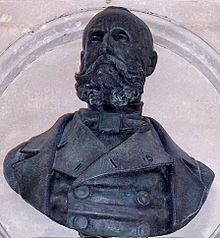Hector-Martin Lefuel
This article needs additional citations for verification. (November 2010) |

Hector-Martin Lefuel (14 November 1810 – 31 December 1880) was a French architect, best known for his work on the
Biography
He was born in
He won of the Prix de Rome in 1839 and subsequently spent the years 1840 to 1844 as a pensionary of the French Academy in Rome at the Villa Medici, together with Ernest Hébert (laureate in painting) and Charles Gounod (music). On his return to France he opened his own practice and was appointed a building inspector for the Chamber of Deputies.
Having carried out alterations as the

Following the sudden death of the architect
After the Tuileries Palace was destroyed by fire in 1871, Lefuel was in charge of the repairs to the pavillon de Flore and the symmetrical reconstruction of the pavillon de Marsan to the north, in 1874–1879.[3]
He had been elected to the

Lefuel also designed and erected the hôtel particulier of Achille Fould, Minister of Finance under Napoléon III, and that of the museum director Émilien de Nieuwerkerke (the Hôtel de Nieuwekerke in Parc Monceau) and the Hôtel Émonville in Abbeville.
He designed funeral monuments, such as that to the composers
His palace in Louis XIII style at Neudeck (Świerklaniec), Polish Silesia, built in 1868–1872, the grandest of three residences there of the Donnersmarcks, was burnt out in 1945 and demolished in 1961.
Hector-Martin Lefuel died in Paris and is buried at Passy Cemetery.[4]
Gallery
-
Pavillon Sully at the eastern end of the Cour Napoleon[5]
-
Perspective view of the Richelieu Wing (1857)
-
Grand Salon of the Napoleon III Apartments[6]
-
Central chandelier of the Grand Salon
-
Great Dining Room of the Napoleon III Apartments
-
Salle d'Auguste (originally Salle des Empereurs)[7]
-
Mollien Pavilion of the Denon Wing
-
Cour Lefuel (Denon Wing) with horse ramps leading to the former Emperor's Stables
-
Tympanum over the door to the former stables from the Cour Lefuel
-
Salle du Manège (former stables)[8]
-
South facade of the Guichets du Carrousel (1861)[9]
-
Pavillon de Flore, south facade[10]
Notes
- ^ Philip Gilbert Hamerton (1885). Paris in old and present times. p. 38.
- ^ Augustus John Cuthbert Hare (1887). Paris. G.Allen. p. 20.
- ^ Aulanier 1971, pp. 91–93.
- ^ Kirkland, Stephanie (22 December 2011). "Paris Places: Passy Cemetery Archived 2016-04-22 at the Wayback Machine. Retrieved 4 March 2014.
- Second Empire style. (Mead 1996, p. 69)
- Maria Walewska. The apartments were occupied by the Finance Ministry from 1872 to 1989. (Bautier 1995, pp. 144, 170)
- ^ The Assembly of the Gods on the vault was painted by Louis Matout (1865). This room should not be confused with the Salle des Empereurs Romains of the 1790s in the former Summer Apartment of Anne of Austria. (Bautier 1995, pp. 144)
- ^ The decoration, conceived by Lefuel and executed in 1861 by Frémiet, Rouillard, Jacquemart, Demay, and Houguenade, includes capitals with heads of horses and other animals evoking the hunt. (Bautier 1995, pp. 144, 154)
- Third Republicwith The Genius of the Arts by Mercié. (Bautier 1995, pp. 137, 144)
- ^ Carpeaux's Imperial France Enlightens the World, flanked by the allegorical male figures Science and Agriculture, surmounts the pediment, and below, his frieze of Flora leaning over a group of children, is "unquestionably the most famous work of sculpture on the whole exterior of the Louvre." (Bautier 1995, p. 129)
Bibliography
- Aulanier, Christiane (1971). Histoire du Palais et du Musée du Louvre: Le Pavillon de Flore. Paris: Éditions des Musées nationaux. OCLC 468520874.
- Bautier, Genevieve Bresc (1995). The Louvre: An Architectural History. New York: The Vendome Press. ISBN 9780865659636.
- Mead, Christopher (1996). "Lefuel, Hector-Martin", vol.19, pp. 69–70 in ISBN 9780333749395.

![Pavillon Sully at the eastern end of the Cour Napoleon[5]](http://upload.wikimedia.org/wikipedia/commons/thumb/2/2c/Pavillon_Sully_du_Louvre_002.jpg/152px-Pavillon_Sully_du_Louvre_002.jpg)

![Grand Salon of the Napoleon III Apartments[6]](http://upload.wikimedia.org/wikipedia/commons/thumb/8/8e/Appartements_Napol%C3%A9on_III_4.jpg/303px-Appartements_Napol%C3%A9on_III_4.jpg)


![Salle d'Auguste (originally Salle des Empereurs)[7]](http://upload.wikimedia.org/wikipedia/commons/thumb/8/83/P1080712_Louvre_salle_romaine_rwk.JPG/196px-P1080712_Louvre_salle_romaine_rwk.JPG)



![Salle du Manège (former stables)[8]](http://upload.wikimedia.org/wikipedia/commons/thumb/a/a7/Palais_du_Louvre_-_Salle_du_Man%C3%A8ge_-0a.jpg/269px-Palais_du_Louvre_-_Salle_du_Man%C3%A8ge_-0a.jpg)
![South facade of the Guichets du Carrousel (1861)[9]](http://upload.wikimedia.org/wikipedia/commons/thumb/a/a7/Guichets_du_Louvre%2C_Paris_25_June_2011.jpg/366px-Guichets_du_Louvre%2C_Paris_25_June_2011.jpg)
![Pavillon de Flore, south facade[10]](http://upload.wikimedia.org/wikipedia/commons/thumb/f/f9/Le_pavillon_de_Flore_3.jpg/151px-Le_pavillon_de_Flore_3.jpg)